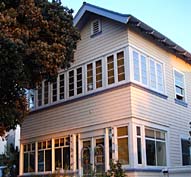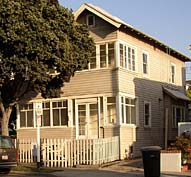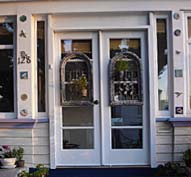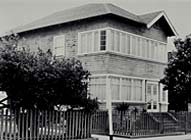




128 Hollister Avenue


128 Hollister Avenue
American Foursquare built 1905
photo by Michael Grandcolas

Wide angle view

Entrance
photo by Michael Grandcolas

128 Hollister Avenue.
Photo by Claudia Aronson
By 1909, two story cottages flanked both sides of Hollister and Wadsworth Avenues. Craftsmen, Victorians and American Foursquare dwellings, lined the block. This property at 128 Hollister is located on the south side of the street between Neilsen Way and Ocean Avenue. The wood framed house was constructed in 1905 in a rectangular shape; it is typical of the American Foursquare in that it has two to two-and-a-half stories, a nearly square floor plan, and a blocky shape, topped by a low pyramidal or hipped roof.
A bargeboard accents the small gable and exposed rafters appear in the open eaves. It has overlap wood siding and is punctuated by a variety of window types.
Some of the locals say that the windows are so varied because this building was the old train depot building. Local legend has it that the bottom floor, in addition to being a waiting room, was also a newsstand. The stationmaster lived upstairs.
A band of multi-framed casements - an alteration dated 1918 - wraps the second story, front façade. These enclose what was originally a porch. The first floor porch was also enclosed at this time.
Some locals say that this was because the building went from being mixed use - commercial on the bottom and residential on the second floor - to being completely residential. Those with the City feel that the changes show the evolution of Ocean Park. Originally built to be leased cottages in a vacation area, when the houses became year-round residences, many changes were made to make them more spacious and comfortable. The layers of change on the beach cottages of the Central Beach tract that appeared in the first decades of the 20th century tell the story of the development of the area.
Foursquares are most commonly built in wood frame but they are also found
in stucco, brick and Sears offered a cement block making machine that
could manufacture blocks on site for the house. The style was influenced
by the Chicago Prairie style and has many of the same features, wide eaves,
horizontal emphasis and porch running the full length of the first floor.
American Foursquare houses usually have these features:
• Simple box shape
• Two-and-a-half stories high
• Four-room floor plan
• Low-hipped roof with deep overhang
• Large central dormer
• Full-width porch with wide stairs
• Brick, stone or wood siding